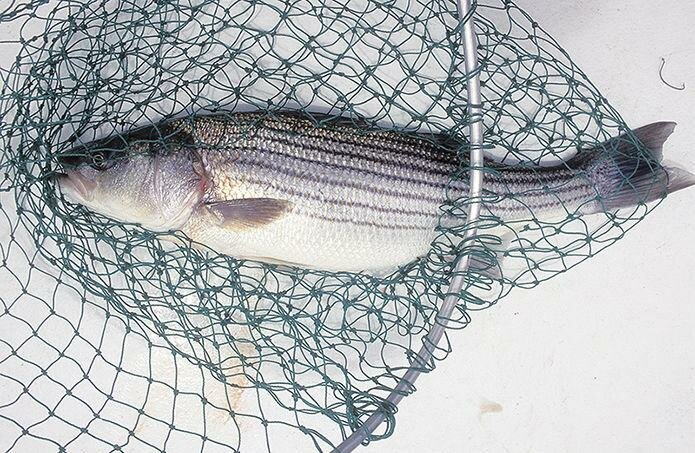Fisheries considering new restrictions
Acting on the heels of poor striped bass spawning reported again in the Chesapeake Bay, East Coast fisheries managers are considering new catch restrictions aimed at curbing the decline of the highly …

You must be a member to read this story.
Join our family of readers for as little as $5 per month and support local, unbiased journalism.
Already a member? Log in to continue. Otherwise, follow the link below to join.
Please log in to continue |
Fisheries considering new restrictions
Acting on the heels of poor striped bass spawning reported again in the Chesapeake Bay, East Coast fisheries managers are considering new catch restrictions aimed at curbing the decline of the highly sought-after migratory fish.
At its annual meeting in North Carolina, the Atlantic States Marine Fisheries Commission’s striped bass board voted Oct. 18 to seek public comment on a suite of conservation measures that could be imposed starting in 2024.
The “draft addendum” to the commission’s striped bass fishery management plan lays out options for setting a variety of limits on the number and size of fish that anglers could catch in the Bay and along the coast. It also proposes reducing the commercial harvest quota by up to 14.5%, on par with the reduction sought in the recreational fishery.
The commission, which represents state fishery managers from along the coast as well as federal agencies, will hold a series of hearings and take public comments in writing on the plan over the next two months. It intends to choose among the options and take final action at its next meeting in January in Arlington, Virginia.
The commission vote came less than a week after the Maryland Department of Natural Resources reported that its annual seine survey of state waters for juvenile fish yielded an average of just 1.02 little striped bass per net haul, far below the long-term average of 11.1. That is the second lowest tally since 1957. It also marks the fifth straight year of seriously subpar reproductive success for the species.
The Virginia Institute of Marine Science also reported finding below-average numbers of young striped bass this year in a similar survey it conducts annually in the lower portion of the Bay. It averaged 4.25 fish per net haul, also below that survey’s long-term average of 7.77.
Those reports are significant because the Bay is the primary spawning and nursery ground for 70 percent to 90 percent of the entire Atlantic coast striped bass stock. Also known in the Chesapeake region as rockfish, they are one of the most popular sport and commercial fish all along the East Coast.
Lynn Fegley, DNR’s Fisheries and Boating director, attributed the poor survey results in Maryland to warm, dry weather in winter and spring for the past several years, which she suggested in a statement may have hindered reproduction.
As adults, striped bass spend much of their lives roaming the coastal Atlantic Ocean but migrate every spring into the Bay and its tributaries to spawn in fresh water. That typically occurs in April and May, usually coinciding with the growth of zooplankton, a major aquatic food source for newly spawned striped bass larvae.
But research has found that winter weather has a significant impact on zooplankton abundance. Cold, wet winters in the Bay improve the odds for striped bass larvae to find high concentrations of their microscopic prey in April and May. Conversely, warm and dry conditions could upset that timing.
DNR noted that its survey found evidence of below-average reproduction in other anadromous fish that spawn in similar ways, including white and yellow perch and herring.
Striped bass spawning success varies from year to year, but the overall coastal population has been maintained by bumper crops of juveniles produced every few years. This five-year reproductive slump is the longest since overfishing in the 1970s and ’80s led to a near-collapse of the population, prompting catch restrictions coastwide and even a five-year ban on taking any of the fish in Maryland.
The population rebounded from that swoon but is struggling again to recover from recent overfishing. The Atlantic States commission in 2019 had ordered an 18 percent reduction coastwide in fishing-related mortality after studies showed that large numbers of striped bass were dying from catch-and-release by anglers in hot summer months when warm water temperatures stress the fish.
The fishing limits set then were intended to rebuild the striped bass population by 2029, but evidence of a big jump in recreational catch last year along with continued poor spawning prompted the panel to impose an emergency 31-inch size limit on recreational catches in May 2023.
Conservationists said the new curbs proposed by the commission would help but they don’t believe they go far enough in reducing fishing mortality, given the lack of reproduction in recent years. They urged state fishery managers in the Bay watershed to go beyond what the Atlantic States panel is considering and make recreational and commercial fishers share in the cuts.
“Without conservation measures across all fishery sectors, the hope of bringing back this iconic species will be lost,” Chris Moore, senior regional ecosystem scientist for the Chesapeake Bay Foundation, said in a statement.
“There’s dark clouds on the horizon and we must reduce landings,” agreed David Sikorski, executive director of the Coastal Conservation Association Maryland. “It must be equal, and it must be enough.”
Fegley said in a statement that the Maryland DNR is working through the Atlantic States commission to adopt coastwide protections for striped bass until conditions improve for spawning success. But she added that Maryland is also considering additional actions to limit fishing mortality in its waters.






